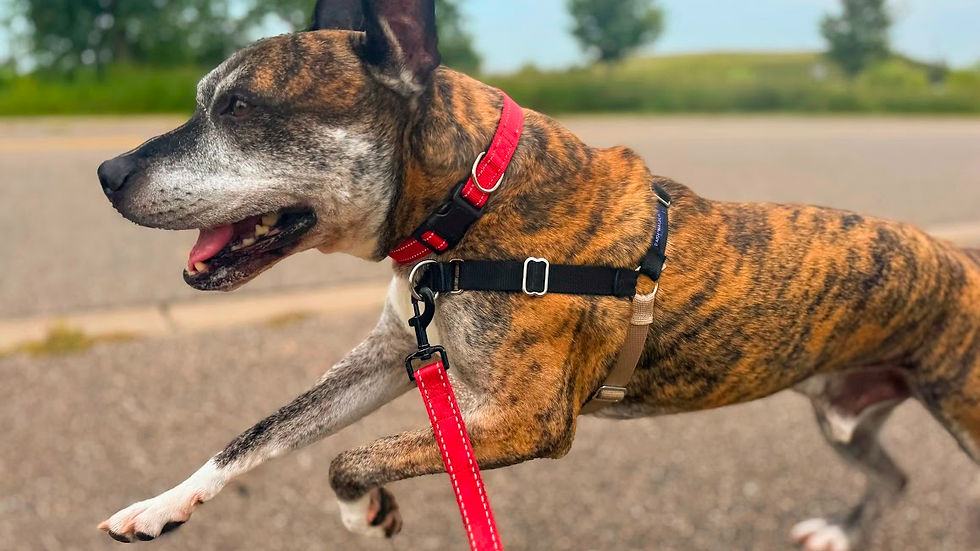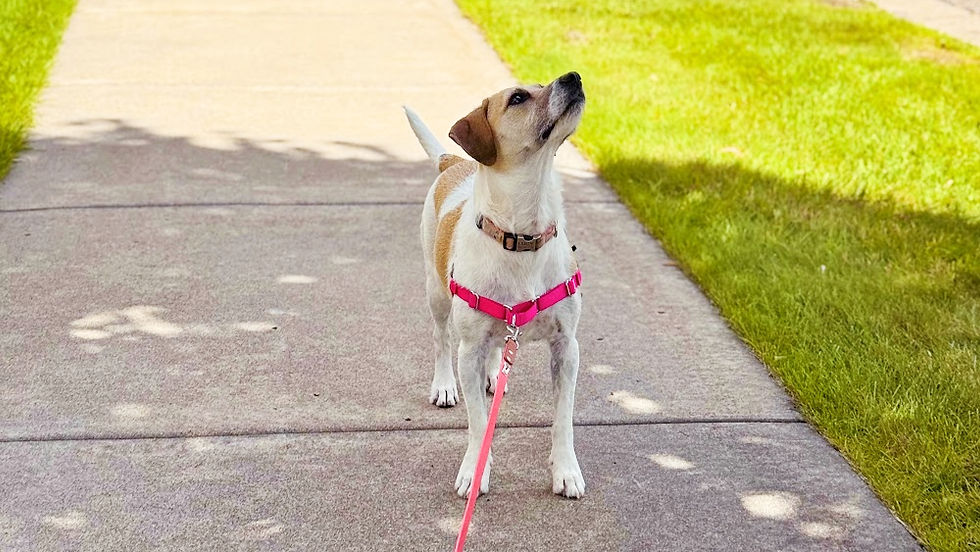Freedom on the Trail: How Long Leads Transform Dog Walks
- Drae Solberg
- Sep 8
- 6 min read
Through AllCompanion Pet Care, I prioritize giving animal companions as much choice and freedom as possible while keeping them safe. One of the ways I do that, especially during hiking adventures, is by using long leads. Long leads create space for exploration, natural movement, and autonomy, without sacrificing safety or respect for the environment we are in.
Whether we are walking a quiet state park trail or taking a scenic route through the neighborhood, a long lead gives dogs (and sometimes cats) more room to move through the world on their terms — all without compromising leash laws, wildlife, or the comfort of others sharing the space.
What is a long lead, and why use them?
A long lead is exactly what it sounds like: a longer leash, usually between 10 and 30 feet, though some are even longer. I use them most often during adventures, but sometimes on neighborhood walks when a little extra space feels right.
Here is what long leads make possible for animal companions:
More space to explore and be naturally curious
A sense of autonomy without the risks of being off-leash
A pace that works for them, as four paws move faster than our two feet
A way to connect with the natural world around them and their natural selves
Some dogs and adventure cats simply need more room to decompress and move naturally. Long leads offer that while keeping everyone safely connected.
Long leads can also help reduce pulling. On a short leash, many dogs pull because they want to move faster or investigate something just out of reach. A long lead removes some of that tension by giving them room to reach what they are interested in without feeling like they have to drag you there. More freedom can lead to less frustration for both of you.
Walks should be about connection, not control.
The leash is often used as a tool for control. Instead, we can view it as a tool to help us connect to our animal companions.
Animals are always speaking, and we just have to be willing to listen. A long lead gives animal companions the space to speak a little more clearly — to pause, wander, and change direction. To follow a scent trail or watch a squirrel from afar. When I use long leads, what I am really trying to let them know is: I trust you to move the way you need to move, and I am right here when you need me (or want chin scratches and butt rubs, of course!).
If anyone or anything unsafe comes up, such as an off-leash dog, wildlife, or trash, I do not yank the leash. I might hold it taut and walk us away, but generally I can walk myself up the lead, folding it as I go, then release it once we are past the distraction or danger.
AllCompanion Long Lead Experts

Gus the Park Ranger
Gus enjoys two local park adventures with AllCompanion each week. He prefers to move slowly, observe as much as possible, and really live in the moment. Sometimes he will have quick, joyful bursts where he runs ahead, and that is where the long lead shines. He can sprint and explore while still staying safely connected to me.
Gus also gets overwhelmed easily, so we stick to quieter parks where he can fully decompress. On quiet trails, I use a thirty-foot lead. In busier parks, we switch to a ten-foot lead as the goal is always to meet him where he is at, and respect the environment we are in.

Ember the Explorer
Sometimes I walk with Ember during sitting visits or busier days when his guardians need a little help, but he explores the neighborhood regularly with them. He is confident, curious, and loves to be outside.
With his long lead and harness, Ember can watch birds, sniff the air, and settle into the plants to watch bugs hop around. His adventures are slow and intentional, and he seemingly would not have it any other way. He does not negatively impact wildlife populations, and he stays safe from cars and other hazards that outdoor cats face.
There is a great difference between walking cats and dogs, and those differences are best explained by Ember's guardian herself:
I generally let my adventure cat, Ember, lead where he wants to go and pause as long as he prefers, within reason. Regardless of the species, my philosophy remains that the walk is for their benefit and enrichment, not mine; so I’ve found that using a long line of around 10-12 feet on walks in familiar territory has made for less stressful walks for us both. He can hang out under bushes without me having to also be in the brush or chase after grasshoppers without the risk of suddenly being yanked backwards by a short tether. Since using a long leash, we also haven’t had to deal with as much pulling from him since he has more freedom to wander than on a shorter lead, and with cats, a looser leash equals less risk of them escaping their harness. Additionally, if an emergency arose (such as an off-leash dog charging us), a long line gives him more space to retreat up a tree or to another safe space if needed, but also a greater chance that I’ll also be able to grab his lead to regroup after the danger passes.
Ember's guardian also made an important point: long leads aren't right for every situation. They work best when your companion is already confident on walks, and it is essential to consider your surroundings before deciding what kind of leash to use.

Albert the Outfielder
Albert's guardian mentioned that he loves running in open spaces, like a baseball field, but his recall is not solid enough yet for off-leash exploration — even in enclosed spaces. So, we tried a thirty-foot lead on a walk together.
He ran and explored while staying safely tethered. It was a great way for all of us to build confidence together as he learned how to navigate the long lead. His guardian ended up getting a long leash of her own so he could have more freedom on his walks.

Lucy the Detective
Lucy is a pup who approaches each walk with different energy levels. Some days, she is full of energy and ready to play! Other days, she is perfectly content with plopping down and taking it slow. But no matter the pace, one thing is always true: Lucy loves to sniff!
She used to pull toward every smell she found interesting. Now, with the help of a PetSafe Easy Walk harness and a ten-foot long lead, Lucy has more space to explore without tension. She stops to rest and watch the world, or leaps ahead, all while staying safely connected.
There is so much we control in our animal companions' lives, including what and when they eat, where they go, and who they meet. It is an uncomfortable truth that the dogs, cats, birds, reptiles, and other animals in our care live within limits we create.
Long leads are one small, powerful way to offer just a little more freedom in this human-centric world. If your companion seems frustrated on short-leash walks, pulls constantly, or wants more space to explore, a long lead might make the difference. It can change the way you move together and build trust through the lead itself.
Want your companion to try a long lead?
AllCompanion Pet Care offers hiking adventures with thoughtful routes, structured exploration, and long leads when it is appropriate. Every adventure is leashed, safe, and always guided by your companion's emotional and physical needs. During a service, we can test out long leads and determine whether or not a long lead could be helpful for your companion.
If you are curious about trying a long lead at home, you can check out High Tail Hikes for the same lines I use on the trail. They come in a variety of sizes and colors, and when you use my affiliate link, you will get a 10% discount.
It is not about distance, speed, or perfect recall. For our companions, it is about quality over quantity, and connection over control. So, get out there! Slow down (or speed up) and let your companion lead the way on your next adventure. 🐾


Comments